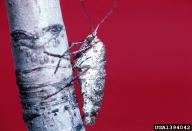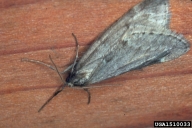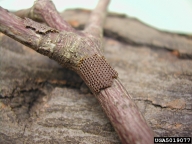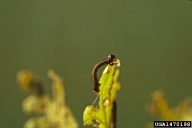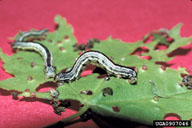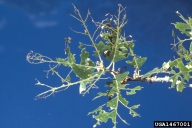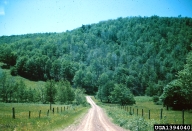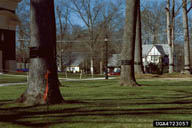Fall cankerworm
Alsophila pometaria (Harris) (Lepidoptera: Geometridae)
Orientation to pest
Fall cankerworm, Alsophila pometaria (Harris), is a native moth capable of defoliating many hardwood species. The species overwinters as eggs, which hatch in early spring to coincide with bud break. Young "inchworm" larvae skeletonize new leaves, while older larvae consume all but the larger veins or midrib. By midsummer, mature larvae crawl down or drop on silk threads to the soil where they pupate in the soil. Adults emerge in early winter (November or early December) after initial frosts to mate. The wingless females climb tree trunks and deposit their eggs in rows in a single layer on smaller branches or trunk. There is one generation per year. In some areas fall cankerworm periodically goes into outbreak, causing widespread damage. Damage results from complete or partial defoliation of forest or urban trees.
Hosts commonly attacked
In North America, larvae of this defoliating moth attack a wide range of hardwoods and shrubs, including elm (Ulmus), maple (Acer), ash (Fraxinus), oak (Quercus), apple (Malus domestica Borkh.), hickory (Carya tomentosa [Poir.] Nutt.), dogwood (Cornus), and many others.
Distribution
This moth has a wide distribution in southeastern Canada and the eastern United States, west to Alberta, Montana, and Missouri, and south to North Carolina.
Images of fall cankerworm
| Figure 1. Adults of fall cankerworm, Alsophila pometaria, left wingless female; right, male | Figure 2. Egg mass of fall cankerworm; note straight rows of eggs in single layer |
| Figure 3. Larvae of fall cankerworm; left, young larva; right, mature larvae | Figure 4. Feeding of fall cankerworm |
| Figure 5. Defoliation of hardwoods by fall cankerworms | Figure 6. Sticky bands on shade trees to trap fall cankerworm females |
Important biological control agents related to this pest species
Relatively few parasitoids have been recorded attacking this species. Among these are the braconid Meteorus autographae Muesbeck and the scelionid egg parasitoid Telenomus alsophilae Viereck. The latter is believed to be the most important parasitoid affecting this species, killing 15-20% of the eggs. A nuclear polyhedrosis virus is also associated with this species and some strains of Bacillus thuringiensis Berliner are effective against it.
Web links for information on fall cankerworm
- Fact Sheet | Pennsylvania State University Extension
- Fact Sheet from Maine Forest Service | Maine Department of Conservation
- Cankerworms Fact Sheet | UMass Extension | Massachusetts Landscape, Nursery, and Urban Forestry Program
Information on fall and spring cankerworms - Fact Sheet | Ohio State University Extension
Articles
- Fedde, G. F. 1980. Spring parasitism of fall cankerworm eggs in northern Georgia by Telenomus alsophilae (Hymenoptera: Scelionidae). Journal of the Georgia Entomological Society 15: 199-206.
- Miller, F., K. Malmquist, and G. Ware. 2001. Evaluation of Asian, European, and North American elm (Ulmus spp.) biotypes to feeding by spring and fall cankerworms. Journal of Environmental Horticulture 19: 216-221.
- France, K. R. and A. R. Westwood. 2006. An assessment of tree banding techniques to capture cankerworm defoliators of elm and ash trees in Winnipeg, Manitoba, Canada. Arboriculture and Urban Forestry 32: 10-17.
